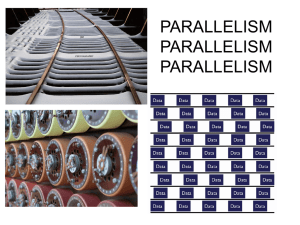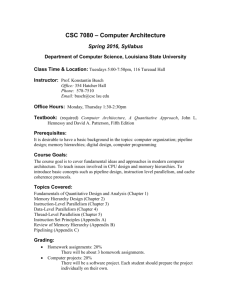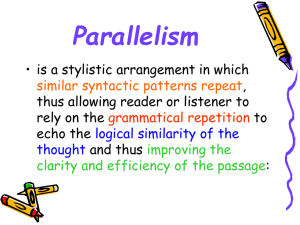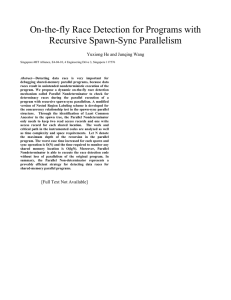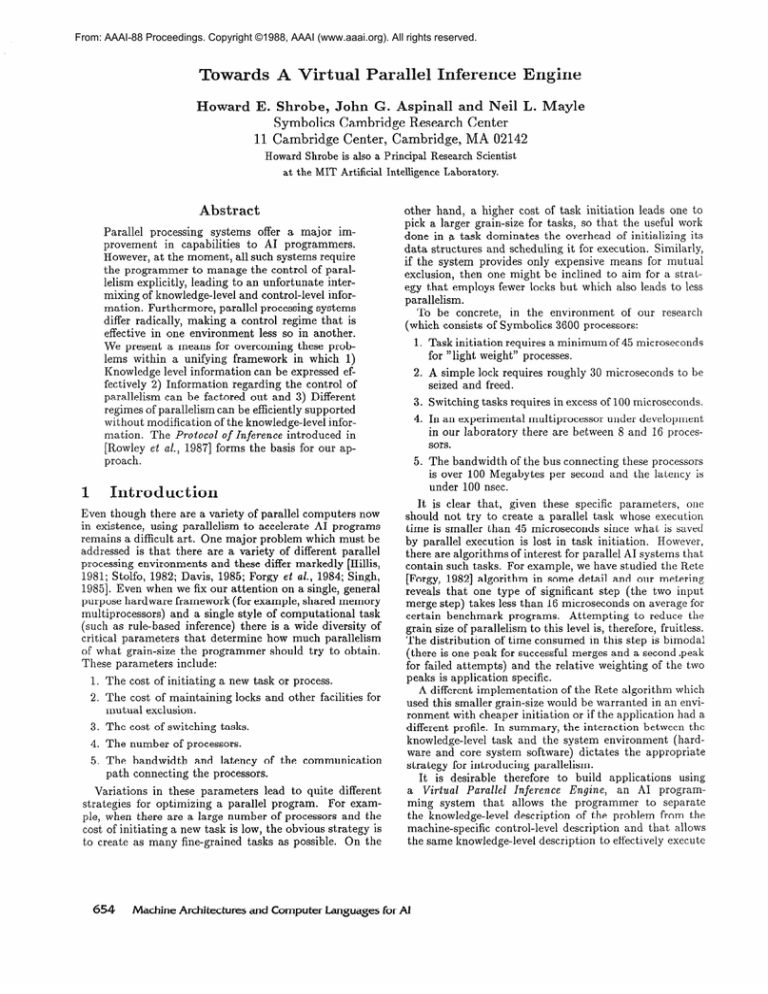
From: AAAI-88 Proceedings. Copyright ©1988, AAAI (www.aaai.org). All rights reserved.
Towards
Howard
A Virtual
Parakll
Center, Cambridge, MA 02142
Howard Shrobe is also a Principal
at the MIT Artificial
Abstract
2. A simple lock requires
seized and freed.
3. Switching
a new task
2. The cost of maintaining
mutual exclusion.
3. The
cost
of switching
4. The
number
locks
facilities
for
tasks.
of processors.
5. The bandwidth
path connecting
and latency
of the
the processors.
communication
Variations
in these parameters
lead to quite different
strategies
for optimizing
a parallel
program.
For example, when there are a large number of processors
and the
cost of initiating
a new task is low, the obvious strategy
is
to create as many fine-grained
tasks as possible.
On the
654
roughly
of 45 microseconds
30 microseconds
in excess
to be
of 100 microseconds.
multiprocessor
under development
there are between 8 and 16 proces-
5. The bandwidth
of the bus connecting
these processors
is over 100 Megabytes
per second and the latency is
under 100 nsec.
or process.
and other
tasks requires
4. In an experimental
in our laboratory
sors.
Even though there are a variety of parallel computers
now
in existence,
using parallelism
to accelerate
AI programs
remains a difficult art. One major problem which must be
addressed
is that there are a variety of different
parallel
processing
environments
and these differ markedly
[Hillis,
1981; Stolfo, 1982; Davis, 1985; Forgy et al., 1984; Singh,
19851. Even when we fix our attention
on a single, general
purpose hardware framework
(for example, shared memory
multiprocessors)
and a single style of computational
task
(such as rule-based
inference)
there is a wide diversity
of
critical
parameters
that determine
how much parallelism
of what grain-size
the programmer
should try to obtain.
These parameters
include:
of initiating
Scientist
Laboratory.
1. Task initiation
requires a minimum
for “light weight” processes.
Introduction
cost
Research
Intelligence
other hand, a higher cost of task initiation
leads one to
pick a larger grain-size
for tasks, so that the useful work
done in a task dominates
the overhead
of initializing
its
data structures
and scheduling
it for execution.
Similarly,
if the system provides
only expensive
means for mutual
exclusion,
then one might be inclined to aim for a strategy that employs fewer locks but which also leads to less
parallelism.
To be concrete,
in the environment
of our research
(which consists of Symbolics
3600 processors:
Parallel
processing
systems
offer a major
improvement
in capabilities
to AI programmers.
However, at the moment, all such systems require
the programmer
to manage the control of parallelism explicitly,
leading to an unfortunate
intermixing of knowledge-level
and control-level
information.
Furthermore,
parallel processing
systems
differ radically,
making a control regime that is
effective
in one environment
less so in another.
We present a means for overcoming
these problems within
a unifying
framework
in which 1)
Knowledge
level information
can be expressed
effectively
2) Information
regarding
the control of
parallelism
can be factored
out and 3) Different
regimes of parallelism
can be efficiently supported
without modification
of the knowledge-level
information.
The Protocol of Inference
introduced
in
[Rowley et al., 19871 forms the basis for our approach.
1. The
Engine
E. Shrobe, John G. Aspinall and Neil L. Mayle
Symbolics Cambridge Research Center
11 Cambridge
1
Inference
It is clear that,
given these specific
parameters,
one
should not try to create a parallel
task whose execution
time is smaller than 45 microseconds
since what is saved
by parallel execution
is lost in task initiation.
However,
there are algorithms
of interest for parallel AI systems that
contain such tasks. For example,
we have studied the Rete
[Forgy, 19821 algorithm
in some detail and our metering
reveals that one type of significant
step (the two input
merge step) takes less than 16 microseconds
on average for
certain
benchmark
programs.
Attempting
to reduce the
grain size of parallelism
to this level is, therefore,
fruitless.
The distribution
of time consumed
in this step is bimodal
(there is one peak for successful
merges and a second .peak
for failed attempts)
and the relative
weighting
of the two
peaks is application
specific.
A different implementation
of the Rete algorithm
which
used this smaller grain-size would be warranted
in an environment with cheaper initiation
or if the application
had a
different profile. In summary,
the interaction
between the
knowledge-level
task and the system environment
(hardware and core system software)
dictates
the appropriate
strategy
for introducing
parallelism.
It is desirable
therefore
to build applications
using
Parallel
Inference
Engine,
an AI programa Virtual
ming system
that
allows the programmer
to separate
the knowledge-level
description
of the problem
from the
machine-specific
control-level
description
and that allows
the same knowledge-level
description
to effectively
execute
Machine Architecturesand Computer Languagesfor Al
as is each rule that manipulates
information
at that level.
Other systems that exhibit a similar high degree of decomposability
can also exploit such an architecture.
Implementing
such a system
using
the protocol
is
straightforward
and involves developing
methods
for the
following protocol
steps:
0 INSERT
which machine should store each rule and either indexes
the rule-trigger
locally or sends a message to the remote
machine requesting
it to do so.
When a rule has satisfied
a query it must call the continuation
of the query to process the result.
If the query
had been posted in a remote machine, this involves sending
a variable binding environment
across the network to the
requesting
machine.
o LOCATE-FORWARD-TRIGGER
l
MAP-OVER-FORWARD-TRIGGERS
INSERT is the subroutine
of TELL which decides where
an assertion
should be stored.
In the uniprocessor
world,
INSERT serves as the hook to create data specific indexers;
in the parallel processing
world, it is also responsible
for
deciding which machine an assertion
should be stored on.
We implement
two INSERT mixins.
The first of these
contains the normal INSERT method that stores the assertion on the local machine.
The second contains an INSERT
method
that forwards
a request
to the remote
machine
where the assertion
should be stored.
Each predicate
definition is specified separately
for each machine;
if the predicate is actually
stored on that machine,
the first mixin is
used. Otherwise
the second one is employed.
LOCATE-FORWARDRules
are handled
analogously.
TRIGGER is the method responsible
for indexing the Rete
network nodes used to trigger forward rules. MAP-OVERis the subroutine
of TELL thatisreFORWARD-TRIGGERS
sponsible
for finding these triggers
and invoking the forward chaining rules triggered
by an assertion.
As with the
data indexing methods
we implement
two versions of this
method.
For each machine,
we mix in the first version if
the rule is stored locally and the second version otherwise.
This approach
is a minor modification
of the techniques
used for sequential
programs.
The major difference is that
some work is distributed
across the network to remote machines. The protocol allows us to do this simply by mixing
in the appropriate
methods.
3.1.2
Loosely Coupled Backward Chaining
A backward chaining system can exploit this loosely coupled environment
if it can be decomposed
into nearly independent modules of expertise.
Each of these modules runs
independently,
but when it needs services from a remote
specialist,
it must send a request through the network.
Such a Loosely
coupled
backward
chaining
system
is
also easy to capture
within our protocol.
As in the previous model, we assign the statements
and the backwardchaining rules associated
with a particular
packet of expertise to a particular
machine.
The new protocol methods involved in this approach are:
e LOCATE-BACKWARD-TRIGGER
e MAP-OVER-BACKWARD-TRIGGERS
To gain parallelism,
we modify the ASK-RULE part of
the ASK protocol
to undertake
two operations
in parallel.
The first is the processing
of those rules stored locally. The
second is the sending of the query to each remote machine
containing
relevant rules. This behavior is captured
in the
h/IAP-OVER-BACKWARD-TRIGGERS
protocolstep
whichis
a subroutine
of ASK-RULE.
LOCATE-BACKWARD-TRIGGER
is the routine
that indexes backward-chaining
rule triggers;
this method decides
656
3.1.3
Comments
on the Approach
Sending a message through
the network is very slow by
comparison
to the time it takes to implement
any protocol
step on a local machine.
Thus, this approach
only gains
performance
if: 1) There is a natural
coarse-grained
partitioning
of the problem and 2) The processing
performed
in response
to remotely
triggering
a rule is quite large.
This will be true if the body of the rule invokes a major computation,
or if it triggers
a large number of rule
firings localized
to the remote machine.
Failing this, the
approach
will lead to overall system
degradation
rather
than speedup.
There is no inherent reason for assigning a
rule to a specific machine.
In [Singh, 19851 rules are replicated in each machine,
allowing
any machine
to apply a
rule immediately
if it isn’t busy. Otherwise
it broadcasts
the goal, providing work for other machines.
The implementation
of the backward
chaining
system
must be careful about its treatment
of logic-variable
bindings since the standard
shallow-binding
scheme used in
Prolog is incompatible
with the Or-parallelism
introduced
here; however, space does not allow us to discuss this in
detail here.
3.2
Closely
Coupled
Systems
In the next two sections
we will assume a hardware
environment
consisting
of a shared-memory
multiprocessor.
This greatly reduces the cost of sending a task to a remote
processor since this involves only adding and removing entries from a task queue. This allows much greater opportunity for parallelism
and for smaller grain-sized
tasks.
3.2.1
Closely Coupled Backward Chaining
Our model for backward-chaining
in this environment
achieves
both and-parallelism
and or-parallelism
and is
rule,
similar to [Singh, 19861. F or each backward-chaining
we create a Rete network whose initial nodes correspond
to the subgoals in the IF part of a backward-chaining
rule.
After the rule is triggered
and the THEN part of the rule
has been matched
to the query, a task is created for each
of the subgoals in the IF part of the rule. Each task instantiates its subgoal with the variable bindings of the match
and then posts a query for solutions
to the instantiated
subgoal.
Since the only variables
instantiated
in the posted subgoals are those of the THEN part of the rule, it is possible
to receive solutions
to two of the subgoals
that inconsistently instantiate
the other variables.
This is the point of
the Rete network.
A solution to a particular
subgoal is
sent to the corresponding
node of the Rete network;
the
Rete algorithm
then finds all sets of mutually
consistent
solutions
to the subgoals.
The continuation
of the query
is called for each solution that emerges from the terminal
node of the Rete network, producing
the and parallelism.
Machine Architecturesand Computer Languages for Al
Implementing
protocol steps:
this
model
involves
use of the
following
o MAP-OVER-BACKWARD-TRIGGERS
o COMPILE-BACKWARD-ACTION
The first of these is modified to trigger the relevant rules
in parallel.
The second of these methods
is used to customize
how
the rule-compiler
treats the IF part (or the right-hand
side)
of the rule. It builds the Rete network and emits code for
each subgoal which posts the instantiated
query for the
subgoal and feeds each solution
to the appropriate
Rete
network node.
3.2.2
Closely Coupled Forward Chaining
This approach
has been discussed
widely in the literature [Okuno & Gupta,
1988; Stolfo,
19821, particularly
in
t,he context
of OPS-5 implementations.
OPS-5 imposes a
sequential
bottleneck
in order to perform the conflict resolution step. We remove this restriction
in our model.
The IF part of Forward chaining rules is normally compiled into a Rete network.
The THEN part of the rule
is normally compiled
into a sequence of TELL statements,
one for each pattern.
Parallelism
can be achieved by compiling the THEN part into parallel
TELL statements.
In
addition,
the Rete network implementation
can introduce
parallelism
by creating
separate
tasks to handle the processing of individual
statements.
Further
parallelism
can
be introduced
by creating separate tasks to handle the substeps of processing
an individual
statement.
The relevant
protocol steps are:
e h/IAP-OVER-FORWARD-TRIGGERS
o COMPILE-FORWARD-TRIGGER
e COMPILE-FORWARD-ACTION
The first of these is the run-time
routine used to fetch
relevant
rules when a statement
is asserted;
this protocol step introduces
the opportunity
to exploit parallelism
within the process of rule lookup.
The second two methods are called by the rule compiler during the compilation
of forward rules. COMPILE-FORWARD-TRIGGER
is the interface to the part of the compiler
that builds the Rete
network.
The last method controls how the THEN part of
a forward-chaining
rules is compiled;
it provides the opportunity to make the actions on the right hand side execute
in parallel.
3.2.3
Comments
on the Approach
The approach
requires a shared memory multiprocessor
in which separate
processes
share address space. This approach can lead to lots of parallelism,
particularly
if the
Rete network implementation
is designed to maximize par:
allelism.
However,
as we stated in the introduction,
one
must be careful.
If the grain size of a task is reduced to the
point where its startup cost is comparable
to its execution
time, nothing is gained; as we mentioned
earlier, some of
the primitive steps of the Rete algorithm
exhibit this problem. In addition,
parallelism
in the Rete network requires
us to enforce mutual exclusion
in critical regions. The cost
of locking may be high and should be carefully considered.
Oltuno and Gupta [1988] d escribe a parallel OPS-5 implementation
with a parallel Rete algorithm
similar to ours.
These
concerns
make a simulation
environment
extremely valuable to help understand
how a particular
system environment
matches
a particular
detailed
approach
to parallelism.
e Simdation
Environments
A simple simulator
of Multilisp
has been written that allows us to investigate
questions
about the maximum
available parallelism
in Lisp applications.
’
In addition,
a second type of simulation
environment
is
provided by the multiprocessing
capability
of the Symbolits Genera operating
system.
In this environment,
multiple
processors
sharing a single memory are straightforwardly
simulated
by separate processes running on a uniprocessor.
4.1
Simulating
Parallelism
Varying
Degrees
of
The Multilisp
simulator
runs in a single process and consists of two parts.
The first part simulates
the execution
as if every future that is created immediately
finds a processor available to run it. This shows the maximal amount
of parallelism
available to the program.
The simulator
works by keeping track of an imaginary
“simulation
clock”. Between requests
to create and evaluate futures (that is when normal,
serial, Lisp is running)
the simulation
clock simply tracks the normal process time.
When futures are created,
the creation
time of the future
is recorded
in the future.
When the future is run, the
simulation
clock is “backed
up” to the creation
time of
the future,
and advances from that point.
The use of resources for which there may be contention
is also recorded
by noting the time periods for which a resource is “locked”
against competing
users.
The result of the simulation
is a history, which has the
structure
of a graph. Each arc in the history corresponds
to the serial execution
of some piece of Lisp.
A grapher
tool allows us to display the history
in graphical
form,
and extract
certain
statistics
(e.g.
processor
utilization,
speedup over serial execution).
The history of program execution
contains sufficient
information
to construct
other histories
under conditions
of
limited parallelism.
This is what the second part of the
simulator
does. The re-simulator
takes a maximally
parallel history, a number of processors,
and an argument
describing the scheduling
policy. It performs an event-driven
simulation
and returns
another
history
which represents
the execution
of the same program
under those new conditions.
4.2
Simulation
by Multiprocessing
Simulation
by multiprocessing
is done by writing programs
using the normal techniques
of scheduling
and contention
avoidance,
and then creating
several processes
(each emulating one processor
in a multiprocessor)
which then look
for tasks in a shared queue.
Each process
can then be
metered separately
using standard
tools.
‘Strictly speaking, the language we simulate is not Multilisp,
which is based on Scheme, but an equivalent language based on
adding Multilisp constructs to Common Lisp. The distinction
is
basically a syntactic one and unimportant to the investigation.
Shrobe, Aspinall and Mayle
657
4.3
Comparison
of the Two Techniques
5.2
Each of the two simulation
techniques
has advantages
over
the other. The Multilisp
simulator
has the advantage
that
one simulation
running real code can be resimulated
under
varying conditions
in a controlled
fashion.
Metering
the
original simulation
is easy, since it happens in one process,
and resimulation
is free of variations
induced by scheduling
policy, paging overhead,
and the like.
On the negative
side, it is easy to perform
a resimulation
that does not
obey causality
constraints.
If lisp forms ever produce side
effects that will be seen by another future, it is mandatory
to time-stamp
such values. It is easy to overlook such side
effects and so care must be taken to ensure that results
reflect some potential
version of reality.
Simulation
by multiprocessing
is a much closer simulation of the reality of a shared-memory
multiprocessor.
Effectively,
the operating
system is performing
fine-grained
time-slicing
where in the Multilisp
simulator
above, the
resimulator
performed
coarse grained time-slicing.
Causality effects are almost completely
eliminated
because of the
fine-grained
time-slicing,
and shared resource
contention
must be handled
properly
or else the program
will procluce wrong results which are immediately
apparent.
The two techniques
are complementary.
5
Simulation
Networks
of Parallel
Rete
Rete networks
are an important
technique
for achieving
parallelism
in both our models of closely coupled parallelism;
they have been studied
[Gupta,
1984; Okuno &
Gupta,
19881 in the context
of OPS5
execution
model.
Conflict
Resolution
is an important
part of the control
structure
of the OPS5 model but it is a bottleneck
that
limits available parallelism;
for tasks that merely compute
the deductive
closure
of an initial set of facts (theorem
proving or simulation)
Conflict
Resolution
is unnecessary
(since rule execution
order is irrelevant).
Our studies involve programs for which Conflict Resolution
is an artificial
bottleneck,
in particular,
a rule-based
circuit simulator.
5.1
Parallelism
in the R&e
network
Joshua uses a standard
Rete network consisting
of match
and merge nodes. The nodes store states that hold consistent sets of variable bindings.
As matching/merging
proceeds states
propagate
through
the Rete network.
The
need for mutual exclusion
arises if a new state reaches each
of the parents of a merge node at the same time. It is necessary that only one of the tasks merges the two new states
by employing
some form of mutual exclusion.
We have studied a relatively
fine grain locking scheme
that allows more parallelism.
The exact steps that occur
when a new state comes in to a parent node are as follows:
1. Grab
the lock of merge
2. Push
the new state
3. Grab
list.
a pointer
4. Unlock
below.
list at the parent.
to the head of the brother
node’s
state
the lock
5. Do merges
list.
658
node directly
into the state
with states
in the previously
grabbed
state
Task size
Within the matching/merging
process there are many different ways to break up the work into separate
parallelizable tasks. Here is a partial list ordered by decreasing
task
size:
Each individual
firing of a rule spawns a separate
task
in which the all the work associated
with body of t#he
rule gets executed.
A rule body may do several TELLS;
each of these can
be spawned as a separate
task. Each task handles all
of the TELL
protocol
- both the data indexing
and
the rule indexing (matching/merging).
Each state created
by a rete node (match or merge)
can be spawned as a task.
All of the merges of the
state with other states
(in brother
nodes) happens
within this task.
Each individual
merge operation
can be spawned as a
task. Every merge between two states happens in its
own task.
Our metering
tools show that the last of these is below
the threshold
for successful
parallel
execution.
Figure
1
shows the processor
utilization
charts resulting
from simulating the parallel execution
of a rule-based
circuit simulator using the first three of the above options.
As can be seen, speedup continues
up to 32 processors
although
cost effectiveness
decreases
somewhere
between
8 and 16 processors.
Larger simulations
would effectively
utilize more processors.
6
Conchsions
Our initial explorations
suggest that the Joshua Protocol of
Inference can be effectively
used to build a Virtual Parallel
Inference
Engine.
It cleanly separates
the control of parallelism from the expression
of task knowledge and allows
the same rule-base
to be executed
in both sequential
and
parallel environments
without modification.
Furthermore,
it allows the same rule base to be executed
in a variety
of different parallel environments,
tailoring
the strategy
to
the detailed
nature
of the system.
Again this does not
involve modifying
the knowledge-level
structures.
However,
there are still many difficult
problems
to be
confronted.
So far we have conducted
limited studies of
programs which can be correctly
executed
without enforcing ordering constraints
between the rules. There are natural classes of problems
(such as deductive
closure and
simulation)
where this is allowable.
But there are many
problems for which this is not true and some control must
be placed over rule execution.
The conflict resolution
step
of OPS-5 imposes a serial bottleneck
after every rule’s execution,
artificially
limiting
the ability
to exploit
parallelism. We are searching
for other control techniques
that
are more explicit
and less limiting.
We also recognize that our descriptions
of the use of the
Protocol
to implement
parallelism
are limited and naive.
There are obviously
many other ways to capture
parallelism. We believe that our approach
has one distinct
advantage, namely its ability to include and experiment
with
any new technique
that arises.
Machine Architectures and Computer Languages for AI
87%719155159-
411122-
329649 -
321944 -
319259 -
316867-
464676 -
3%304-
392697 -
389165 -
N=16
484832-
521266-
N=32
r&397659@387-
637402 -
473124 -
71-2
745763-
-
N=2
1113174llH74812%276813s6s451432453-
Figure
circuit
N-1
1: Processor
utilization
as a function
simulation.
Time increases
downward;
of N, the number of processors
available,
the graphs show the number of processors
while
active
performing
a rule-based
as a function
of elapsed
time.
This work was supported
by NASA
contract
NAS2-12616.
eferences
[Davis, 19851 A. Davis and S. Robison.
The Architecture
of the FAIM-1
Symbolic
Multiprocessing
System.
In
Proceedings IJCA I-85, pages 32-38. International
Joint
Committee
for Artificial
Intellligence,
Los Angeles,
August 1985.
[Forgy et al., 19841 C. Forgy, A. Gupta, A. Newell and R.
Wedig.
Initial Assesment
of Architectures
for Production Systems.
In Proceedings AAAI-84, pages 116-120.
American
Association
for Artificial
Intelligence,
Austin
Texas, August 1984.
[Forgy, 19821 C. L. Forgy. Rete:
A Fast Algorithm
Many Pattern
/ Many Object
Pattern
Matching
lem. Artificial Intelligence, September
1982.
[Gupta St Forgy, 19831 A. Gupta
and
surements
on Production
Systems.
University,
1983.
for the
Prob-
C. L. Forgy.
MeaCarnegie-Mellon
[Gupta,
19841 A. Gupta. Implementing
OPS-5 Production
Systems
on DADO.
International Conference on Parallel Processing, August 1984.
[Hillis, 19811 W. D. Hillis.
The Connection Machine
AI Laboratory
T.R. 646, Cambridge
Mass, 1981.
[Okuno & Gupta,
Level Language
5 Proceedings of the Fourth IEEE Conference on Artificial Intelligence Applications, March 1988, San Diego.
[Rowley et al., 19871 S. Rowley, H. Shrobe, R. Cassels and
W. Hamscher.
Joshua:
Uniform Access to Heterogenous
Knowledge
Structures,
or Why Joshing
is Better
than
Conniving
or Planning.
In Proceedings AAAI-87, pages
48-52.
American
Association
for Artificial
Intelligence,
Seattle,
July 1987.
[Singh, 19851 V. Singh and M. Genesereth.
A Variable
Supply Model for Distributing
Deductions.
In Proceedings IJCAI-85, Vol. 1, pages 39-45. International
Joint
Committee
for Artificial
Intelligence,
Los Angeles,
August 1985.
[Singh, 19861 V. Singh and M. Genesereth.
lel Execution
Model for Backward-Chaining
Stanford
Knowledge
Systems
Laboratory,
KSL-85-18,
Stanford
CA, June 1986
PM: A ParalDeductions.
Report
No.
[Stolfo, 19821 S. Stolfo
and D. Shaw.
DADO:
A TreeStructured
Machine
Architecture
for Production
Systems. In Proceedings AAAI-82, pages 242-246.
American Association
for Artificial
Intelligence,
August 1982,
Pittsburg.
MIT
19881 H.G. Okuno and A. Gupta.
HighApproach
to Parallel Execution
of OPS-
Shrobe,
Aspinall
and Mayle
659

